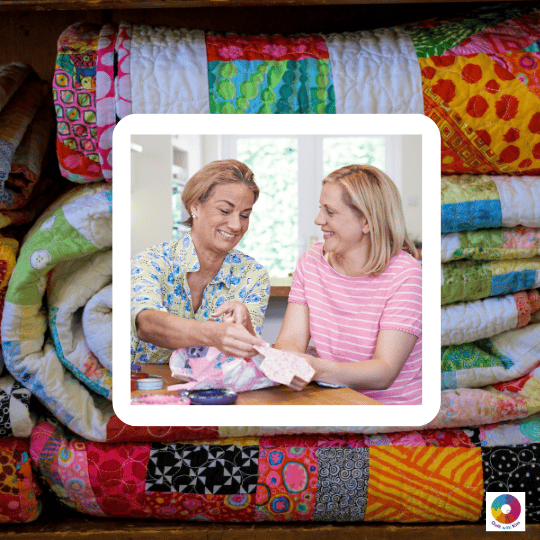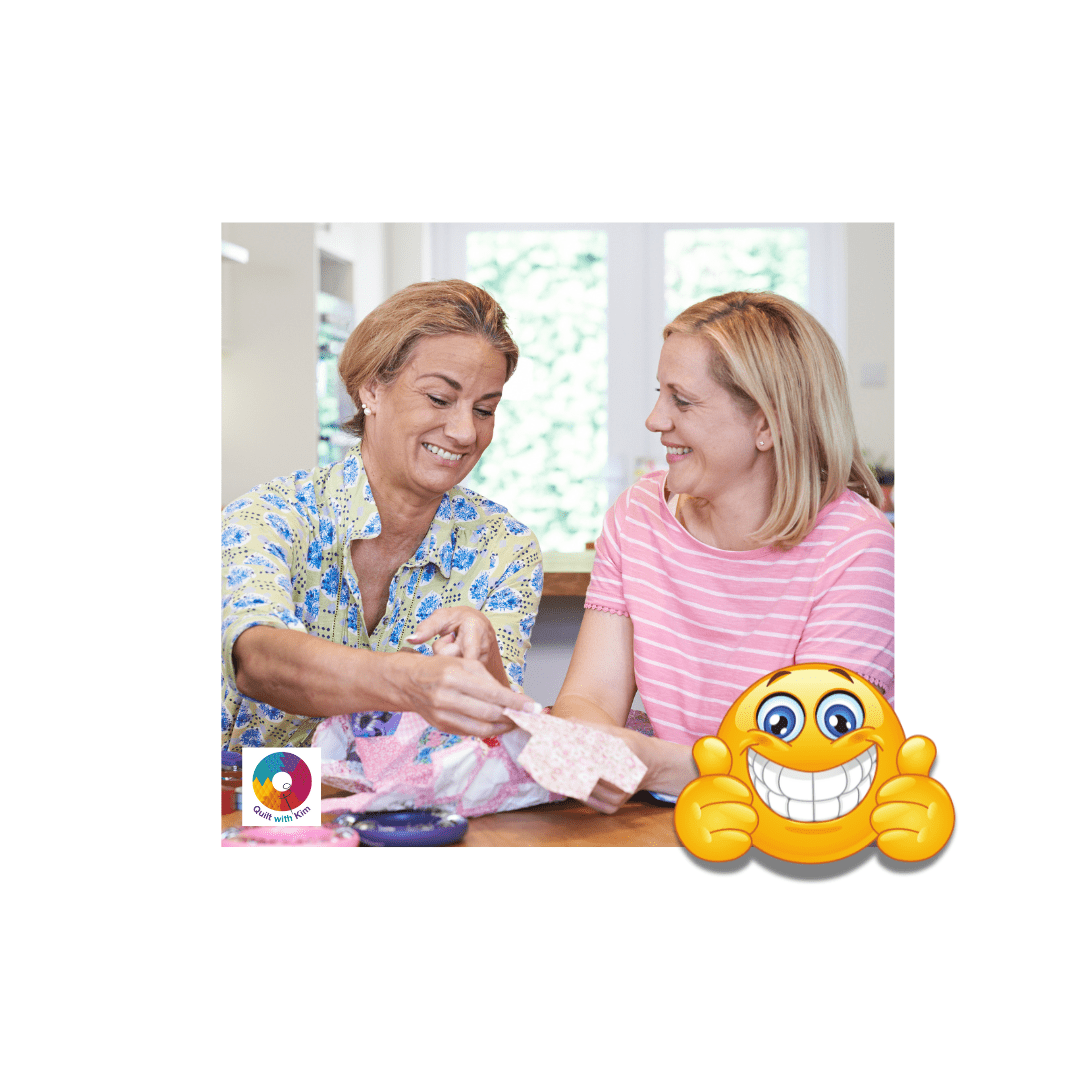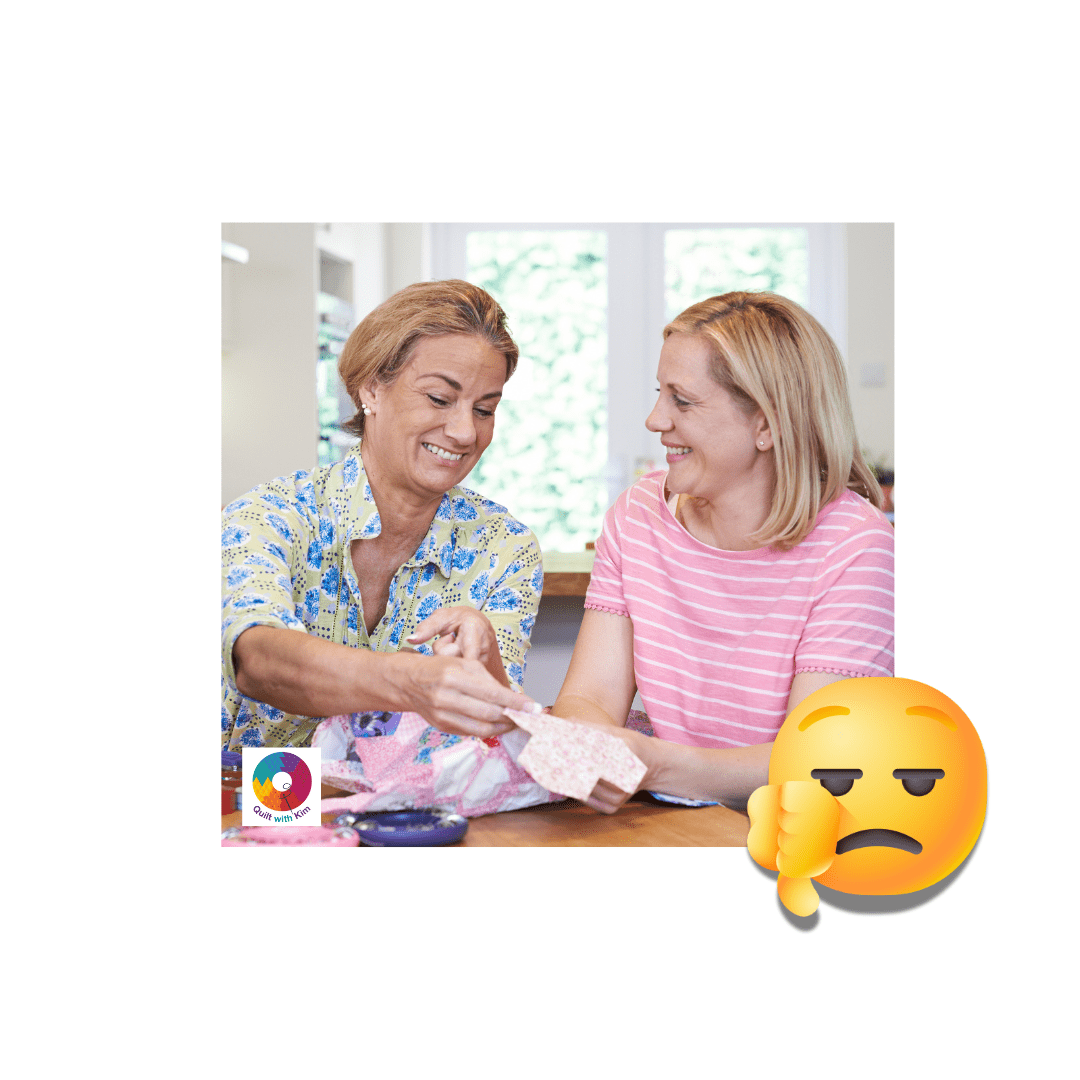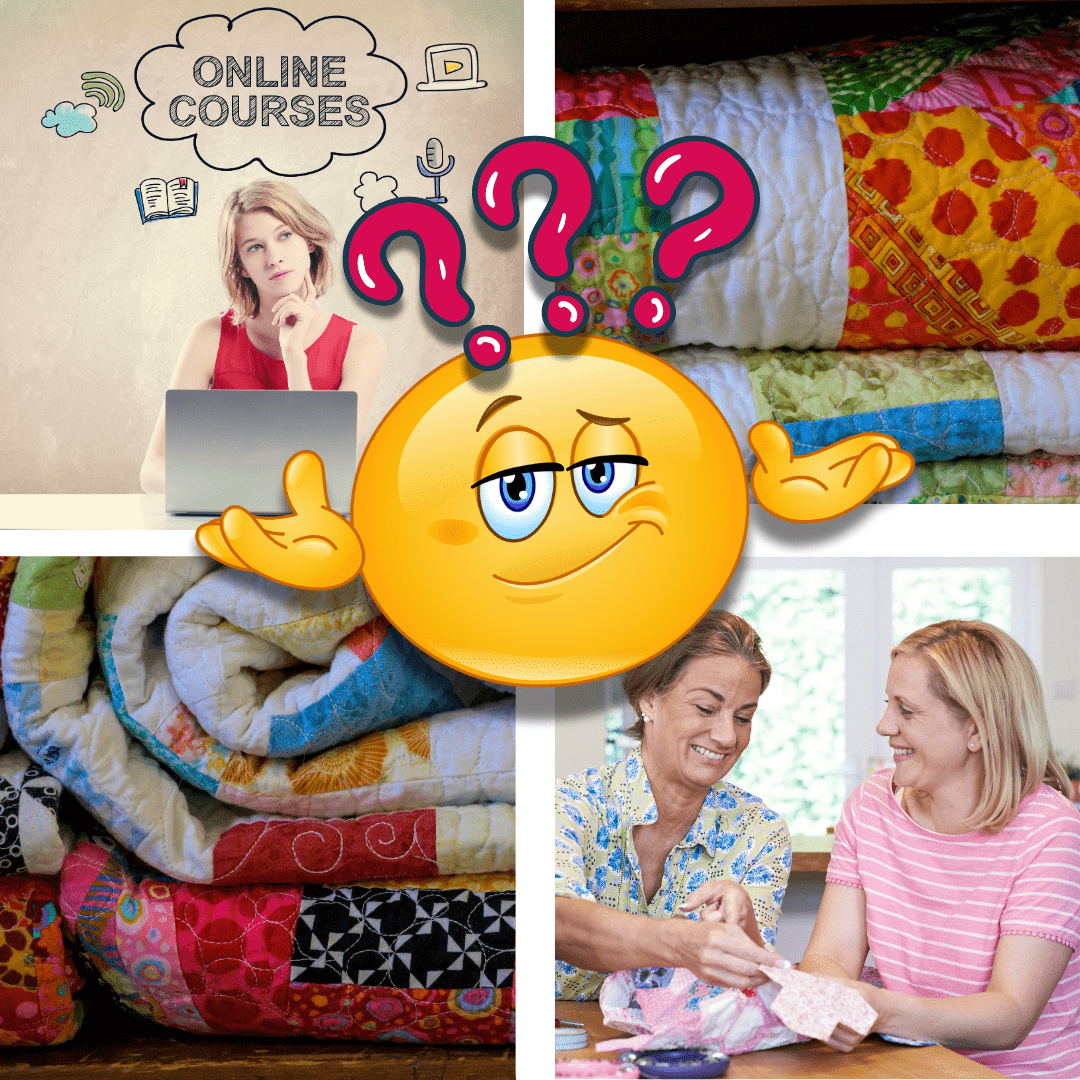Online Quilting Courses vs. In-Person Workshops – Which One is Right for You?
Depending on where you live, you may also be considering signing up for an in-person patchwork and quilting course or workshop.
Is learning in-person better than learning online?
Well, both have their pros and cons, and it really depends on you. So we're going to have a look at a full list of pros and cons of both learning patchwork online and taking a quilting course at your local quilt shop.
Neither is better or worse than the other (which is why it can be difficult to decide between them) so hopefully this will give you a clearer idea so you can make the right decision for YOU.
What Are Online Quilting Courses?
Online courses are a structured, step by step set of lessons to teach you each stage of patchwork and quilting. They are generally taught by experienced quilting teachers who will invest in the time, equipment and technology to bring you comprehensive courses.
The online courses will have several video lessons covering each stage of the project being taught, and come with downloadable resources such as an equipment list, cutting instructions and written instructions.
Once you buy the online quilting courses, they tend to be yours for life which means you can watch as many times as you like and learn at your own pace.
The Pros of Learning with Online Quilting Courses
1. Learn At Your Own Pace
Whether you're a fast learner, or need to take your time, online courses allow you to learn patchwork and quilting at a speed that suits you, and at a time to suit you too. If your local quilt shop ('LQS') only runs its beginners course on a Wednesday afternoon, but you work full time or look after your grandkids, then learning online gives you the flexibility to do the lessons at times that suit you.
2. Accessible Anywhere
Cold, rainy and blowing a gale outside and don't fancy going out? No, I don't blame you. Fortunately, online courses mean you don't need to go anywhere to learn, or indeed you can learn anywhere you have your phone, tablet or laptop (and your sewing machine...and fabric...and sewing kit. OK, maybe stay at home then). On a more serious note, if you actually can't get out to classes for instance if you are a carer or you have a disability, then online courses are likely to be perfect for you.
3. Lifetime Access
As I mentioned in the intro, when you buy an online course, you'll get lifetime access and will be able to access the lessons as many times as you like.
NB what does 'lifetime access' mean? It normally means the lifetime of the course, not your physical lifetime or the tutor's physical lifetime. The lifetime of the course will mean a number of years, and if the tutor is going to take the course down, they will (should) give you the opportunity to download the videos to your own computer.
4. Cost-Effective
Whilst online courses cost money (between £30 - £100), they are likely to be cheaper than going to an in-person workshop or course. Factor in the saving in cost of fuel, parking etc, and learning online will work out more cost effective.
5. Structured Learning
Online quilting tutors will have a lot of experience in teaching in-person, and will have built up a lot of knowledge in how to structure a course and what the steps are for teaching it. So, when you buy an online course, you will find that you have a structured step by step path to follow, and as long as you have a good tutor and work through the lessons in order, you are unlikely to disappear down an overwhelming rabbit hole.
6. Additional Resources
Generally your online courses will include a full downloadable pattern, any templates that are needed, cutting lists and fabric and equipment lists and any other resources that are relevant to the course you are taking.
7. Community Support
You may have overlooked this, but most online courses will have some kind of community or discussion forum attached to it, so you can connect with other students at a similar stage to you online. This is also great if you like being sociable on your terms :D
So....what about the downsides of learning online then?
The Cons of Learning with Online Quilting Courses
Whilst there are lots of benefits with learning online. there are a few challenging areas that you may want to consider too. These are:
1. No Immediate Hands-On Help
Whilst you probably will have some kind of support from your online course tutor, what you won't get is immediate help and feedback. It is likely that your tutor will take a few hours to come back to you (especially if they are in a different time zone to you), and on one well known platform, the response was within 48 hours. This may not be a problem for everybody, but it is worth considering if you need lots of hand holding.
2. Tech Learning Curve
Today's technology is amazing and pretty much allows us to learn anything from anyone, anywhere. However, all those courses out there from learning to play piano, to bee-keeping to learning patchwork and quilting need to sit on a special platform (a type of website) so that you can access the lessons and the downloadable resources. These platforms will require you to create a login name and password, and navigate your way around. If you struggle with technology, then there will be an upwards learning curve for you. Or find a willing child to sort you out (which may be quicker).
3. No In-Person Interaction
If you've followed me around the internet for a while, you'll know that I teach in-person, on YouTube AND online. With YouTube, the social / community side is fairly non-existent (although at the time of writing, that is about to change with a new initiative from our good friends at YouTube). With online, you can definitely be part of a community, but this is all online on forums. But the real social interaction, the gossip, the chat and the type of laughter that requires a Tena Lady (hey, come on, if you're over a certain age, you know what I'm talking about), only comes with the in-person courses.
4. Requires Self-Discipline
I have to be the very first to hold up my hand and admit to buying online courses and then never actually doing them. I have all the greatest intentions, and they seemed like a great idea at the time, but then I never get to the first log in. To be fair, these are normally courses that I buy on a bit of whim, but even so, online courses do require you to be self-motivated and self-disciplined enough to log in and do the lessons. So if you aren't either of those things, and you know you are the world's biggest procrastinator and you need someone peering over your shoulder to motivate you, then learning online probably isn't for you and you need to hot-foot it down to your local quilt shop.
What Are In-Person Quilting Workshops?
In-person workshops and classes are held at a physical location such as your local quilt shop, a village hall, a school hall or even in your tutor's home. These days, you may also find live in-person courses online too.
They will vary in length and could be anything from a day for a simple project, right through to a year for a full-on sampler quilt.
In a live classroom setting, you will get a good social vibe; even if you don't know anyone when you start, you'll soon become best buddies. Some of my earlier groups of students are still friends nearly a decade later, long after they don't need me to teach them anymore!
Why Choose In-Person Quilting Workshops?
1. Instant Hands-On Help
As a tutor, I can walk around my students and immediately see what's going wrong, or what needs adjusting before they go any further. For my students – for you – this means you get some technique correction, mistakes can be easily and immediately fixed, or trouble can be avoided, live and straight away. That can head off all manner of problems (and stop a lot of unpicking too!).
2. Social & Community Benefits
I covered this in the section above, but add a box of Tena Lady's to your essential quilting kit. Seriously, I've watched all of my students over the years become great friends outside my lesson groups. You get support from your fellow students, and then there's the laughter. Back to Tena again. Moving on....
3. Easier for Hands-On Learners
If you are the type of person who needs someone to show you, and then help you guide your hands / fabric / thread / machine, then this is a big plus for learning in person. It's also more advantageous if you're not confident with your machine, especially when it goes wrong: often your tutor will have seen very many machines and will be able to sort yours out very quickly.
4. Accountability & Motivation
If you've got to turn up every Thursday evening at 7pm or every Saturday morning at 10am, you are going to do that. Becoming part of a group gives you a level of motivation that can't be beaten learning by other methods.
5. Access to Equipment & Materials
You will probably find that your tutor has equipment - such as cutting mats, rotary cutters and rulers - that you can borrow to start with. If you're on a budget this can help you to spread out your investment in quilting equipment. It's also a good way to try before you buy; you will probably find a brand or type of tool or equipment that you like which you can then buy.
Just like the online quilting courses, there are some downsides to learning quilting at in-person classes an workshops. These are:
The Challenges of Learning with In-Person Quilting Courses
1. Higher Cost
In person courses and workshops will come at a cost. Your tutor's time needs to be paid for, along with their insurance, venue costs including heating and lighting, and maintenance and replacement of any equipment you use. So expect to pay around £80 - £120 for a day's workshop, or up to £2,000 for a long course...and anything in between.
2. Fixed Schedule
Your tutor will set the days and times of the workshop or course, and they are then fixed. If you can't make it, then there's no other option.
3. Travel & Location Dependent
Unless the course is held live online, then you will need to travel to the location where the course is being held. This will involve parking (is it free and close by?) and transporting all of your sewing and quilting stuff, including your machine, to that location. If you have any mobility issues, this can be a problem.
4. No Replay Option
You can't rewind a live class! A tutor will have a rough timing schedule in his or her head based on how long it takes to teach a class of students the technique or project. Yes, you can ask questions. There is a point though where the tutor will have to move on otherwise the group won't finish. If you're still confused or stuck, this can be a problem, and you may be too embarrassed to speak up and ask (again) when everyone else seems to have 'got it.' (TIP: your tutor really won't mind if you ask them at the end of the class).
5. Potentially Intimidating for Beginners
I know that it can be a little frightening going to a class. Everyone else can seem so much more experienced than you...surely, you think, none of them ever have trouble sewing a straight line...and they can all thread a machine easily, why can't I?
I can tell you this isn't true: everyone feels nervous learning either sewing or patchwork and quilting. Machines, rotary cutters and sewing a straight line can all seem horrifying to start with, and you may feel like you don't want to show yourself up.
It is natural to feel like this, and ALL of my students have ALWAYS gone on to learn to sew, and have all become good intermediate quilters if they wanted to. There are a handful who have gone on to become experts in their preferred area of stitching and FAR better than me. My job – any tutor's job – is to teach you the skills and techniques, and give you the confidence, to find your sewing groove. Then you fly, and we will love that.
6. Class Pacing May Not Suit You
Different tutors have different styles of teaching. You may find that the style and the pace of teaching in the class you have booked onto doesn't suit you. You may need lots of time spent with you or you've already mastered the technique and sit there waiting for the others to get it. It can be a difficult balance to get right.
Online vs. In-Person Quilting: Which One is Best for You?
How on earth do you decide which is right for you? If you have read the above, then there are some probable stand outs for you, and your decision may be made. But here are a few extra pointers to help you decide:
Online Quilting Courses Are Best For...
✅ Beginner quilters who prefer flexible, self-paced learning.
✅ If you have a busy schedule and need to learn on your own time.
✅ Those without access to in-person quilting workshops nearby.
✅ Beginners who want structured, step-by-step guidance.
✅ Anyone looking for a budget-friendly learning option.
In-Person Workshops Are Best For...
✅ Beginner quilters who learn best through a hands-on experience.
✅ Those who enjoy learning in a social group environment.
✅ Beginners who need real-time help and feedback.
✅ People who struggle with self-motivation and need accountability.
✅ Those who want or need access to a tutor and materials during lessons.
You can, of course, combine both (just like you can with YouTube tutorials and online courses).
Very many beginners start learning with free YouTube tutorials or pay for an online course, and then move onto an in personal workshop or course either at their local quilt shop, which a local teacher, or even with their online tutor if they live locally.
Learning online can be a great addition to those in person workshops, and they can complement each other with additional techniques, or the ability to rewind an online (pre-recorded) lesson.
Final Thoughts: Which Quilting Learning Method is Right for You?
Both ways of learning are entirely valid and successful ways of learning, and it really does come down to your personal choice.
Have a think about your budget, how you like to learn, what time you have available and how flexible you are.
Whichever you choose, good luck and happy quilting!
Kim
x
02/20/2025 16:20:28 +0000










